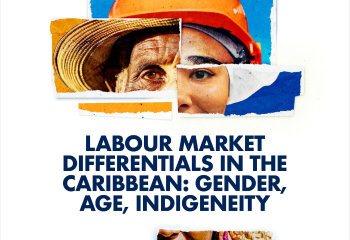Summary Environment and Social Appraisal Geothermal Energy Development Project - St. Vincent and the Grenadines
The Geothermal Energy Development Project - St. Vincent and the Grenadines appraises a proposal for exploratory drilling by the St. Vincent Geothermal Company Limited (SVGCL), a joint venture established between the Government of St. Vincent and the Grenadines (GOSVG) and St. Vincent Geothermal Holdings Limited, to assess the geothermal resource in the La Soufrière region in northern St. Vincent; and for the services of a Community Liaison Officer (the CLO) to support and facilitate stakeholder engagement throughout the project implementation (the Project). The outcome of the Project will be the enhanced capability of SVGCL to make an evidenced based determination of the feasibility of continuing geothermal resource development for electricity production.
In compliance with Caribbean Development Bank' Environmental and Social Review Procedures, the Project is categorised 'B' because of the limited number of specific adverse social and environmental impacts which may result from the proposed activities, and which can be avoided or mitigated by adhering to national regulations and generally recognised performance standards, guidelines or design criteria. An Environmental and Social Impact Assessment (ESIA) and associated Environmental and Social Management Plan (ESMP), was prepared by independent consultants for the Project. An Environment and Social Action Plan (ESAP) has been developed, to ensure that any outstanding issues at the time of project approval, are addressed in a timely and appropriate manner. The ESIA was disclosed in country on April 12, 2016 and was also presented at public meetings.
The potential geothermal field is located on the southern slopes of the La Soufrière Volcano and is bordered by the Mount Pleasant Forest Reserve and the St. Vincent (SVG) Parrot Reserve. Two other proposed protected areas lie within the immediate vicinity of the project area. The forest reserves are critical natural habitats particularly because of the presence of the International Union for Conservation of Nature (IUCN) red listed species and other threatened endemic/restricted range species protected by the SVG Wildlife Protection Act 1991 or included in the SVG List of Species of National Concern.
The primary footprint for project activities is associated with (a) two exploration drill pad sites (W1 and W3); (b) a water system (including a water intake, pipeline, and storage pond); (c) mud pond and geothermal fluid pond; (d) reinjection well pads (one for each site); and (e) upgrading of access roads. Vegetation clearing will be required for the Project, however, this area is not a critical habitat and is common within the immediate area.
The key environmental issues of relevance to the Project, identified for detailed analysis and addressed in the ESMP relate to: (a) soil erosion and landslips from land clearing and levelling activities associated with Construction of drill pads and reinjection well pads and water ponds on steep slopes in a relatively wet environment; (b) disposal of liquid waste and excess material from drill muds and cuttings and other earth works; (c) reliability of water extraction from the Rabacca River to meet the drilling water demands particularly during the dry season; (d) potential loss/degradation of some aquatic habitat; (e) increased noise during continuous 24 hour drilling and blow-testing, resulting in exceedances of IFC night-time noise standards; and (f) temporary degradation of habitat quality of the St. Vincent Parrot and the St. Vincent Whistling Frog as a result of noise, light, and increased human activity within the nearby La Soufrière National Park and Mount Pleasant Forest Reserve. Other project impacts include dust nuisances; and geothermal gas emissions which could be generated during drilling and testing; and risks to workers' health and safety. In the event that testing results indicate that the exploration/production wells are not suitable for production, the sites will be decommissioned.
SVG is highly exposed to meteorological and geophysical threats such as seismic events, landslides, flash flooding, hurricanes, and volcanic eruptions. These natural hazards risks could affect Construction, drilling, and testing. An emergency management plan is included in the ESMP to manage these risks to the project.
Social and Gender Assessment
The Project area is located within the Georgetown and Sandy Bay census districts. The Project will affect 1,209 households within these districts. The primary social impacts of the project include:
(a) Construction activities for sites W1 and W3 will occur on crown lands utilised by small farmers and physical resettlement may be required for at least one household and compensation for crop loss;
(b) tourists and other recreational users will be impacted by increasing noise levels and the changing visual landscape near site W1 - located along the access road to the Bamboo Range Hiking Base Station, where hikers ascend the La Soufrière Volcano, one of the most popular tourist attractions in SVG;
(c) temporary traffic disruption for commuters along the windward highway and the project access roads during transport of project equipment and materials from Kingstown Port to sites W1 and W3;
(d) potential damage to culturally important sites along the transport route - particularly at the Byera Tunnel and the Orange Hill Aqueduct. There is also the potential that unanticipated discoveries may occur during Construction, given the number of other archaeological sites known to occur in the project area; and
(e) potential for conflict between foreign workers and local communities and for an increased incidence of negative or harmful practices such as prostitution and the use of illegal drugs, as well as the introduction or spread of diseases such as Human Immunodeficiency Virus/acquired Immunodeficiency Syndrome.
The abovementioned social impacts can be mitigated through adherence to existing national legislation and regulations, as well as implementation of measures outlined in the previously referenced ESMP and ESAP. A Resettlement Action Plan (RAP) has been prepared to deal with land acquisition and economic displacement impacts. Once the detailed design of the civil works is completed the RAP will be updated to include identification of all persons affected by physical and/or economic displacement and the provision of requisite compensation.
A Stakeholder Engagement Plan (SEP) and a grievance redress mechanism (GRM) was developed to support citizen engagement and to keep all persons affected by the project (and other interested stakeholders) informed about Project implementation. The SEP will facilitate addressing community concerns raised through the project' GRM. The implementation of the SEP will be supported by a CLO who will help keep the community informed about the Project and help address community concerns through the GRM. The SEP will facilitate the participation of women in the consultations.
It is expected that hiring for Construction and drilling works will generate more jobs for men than for women; however, women might benefit from income earning activities in the provision of support services to the Project as there will be demand for housing and food to support project implementation.
Environmental and Social Mitigation and Monitoring
Recommended and well-known effective environmental and social mitigation measures and monitoring requirements to avoid, mitigate and compensate for the adverse impacts of the Project is consolidated in the ESMP and ESAP.
SVGCL, as the developer, has from the outset of project design, demonstrated its commitment to adhere to environmental and social performance requirements and best industry practices, to manage the Project' environmental and social impacts. SVGCL will be responsible for overall project monitoring, ensuring compliance with environmental and social policies and obligations in the ESMP, and ensuring that its commitments, are incorporated as contractual specifications.
As a condition precedent to disbursement for the Construction works at site W1, SVGCL is required to provide evidence acceptable to Caribbean Development Bank (CDB) that the key actions from the ESAP such as stakeholder engagement, GRM; RAP update and disclosure; erosion and sediment control measures; worker code of conduct; and CLO have been satisfied.
As a condition of the contingently recoverable grant (GrCL), SVGCL will submit monitoring reports in accordance with the frequencies identified in the ESMP for: air emissions, ambient air quality, noise and vibrations, effluent quality, groundwater quality, and solid waste, to the appropriate authority in SVG. It will be a condition of the GrCL that if Site W1 is determined to be unsuitable for production that SVGCL decommission the Site in accordance with IFC guidelines.
The Engineering Consultants will monitor the contractors' environmental performance and compliance with the mitigation measures stipulated in the contract documents and provide routine reports to CDB. CDB staff will carry out at least two supervision visits in collaboration with IDB and may also utilise services of independent consultants if deemed necessary.


